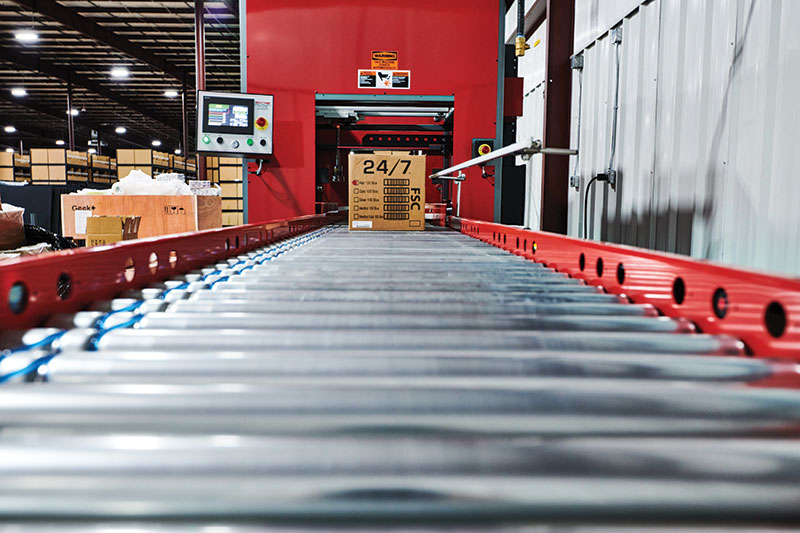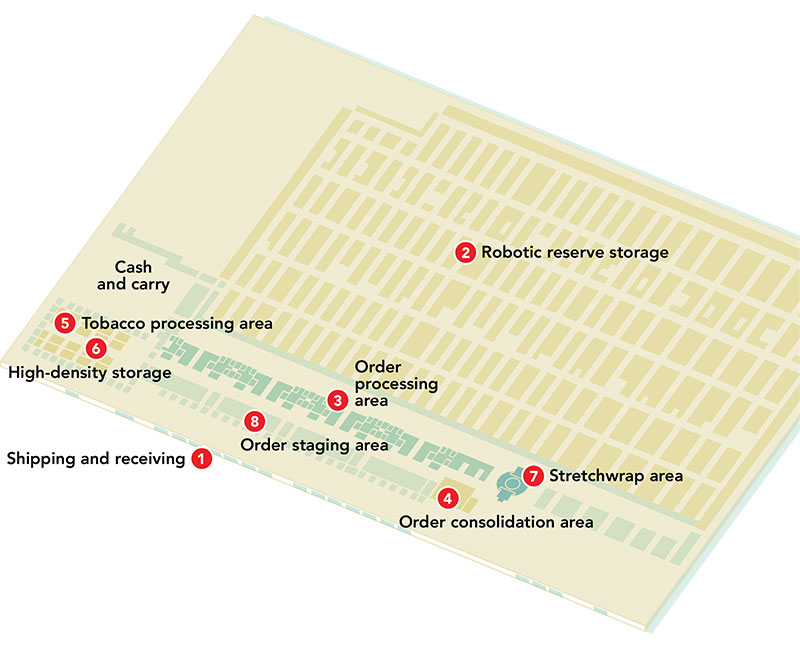Inside C-StoreMaster’s DC: Convenience store distribution simplified
At its new Huntsville, Ala., distribution center, C-StoreMaster has created stripped down and simplified processes to serve its customers.

C-StoreMaster
Location:Huntsville, Alabama
Square Footage:135,000 square feet
Products Handled:Tobacco, beverages and other products sold in convenience stores
SKUS:5,000
Throughput:Up to 200,000 line items per shift
Days/Week, Shifts/Day in Operation:1 shift per day, 5 days per week
Read the full feature story on C-StoreMaster’s Convenient automation
The processes at C-StoreMaster were designed to minimize the number of times a product is touched and maximize efficiency. It’s a deceptively simple design that makes optimal use ofrobotics.
Receiving:Incoming product is unloaded in the shipping and receiving area(1)with a manual lift system from trucks and vans and placed on a pallet. The product is then entered into thewarehouse management system (WMS)as ready for putaway.
Putaway:Pallets are transported by a pallet-handling autonomous mobile robot (AMR) and putaway into the robotic reserve storage area(2). It’s now available to promise. About 60% of the merchandise in the facility is stored at the pallet level and picked from the pallet.
Picking:Convenience store items are bulk picked and item picked at workstations in an order processing area(3). There are distinct processes for bulky items like beverages, general merchandise, and tobacco. Similarly, items are batch-picked during the day, and then consolidated in the evening in a consolidation area(4).
Bulk items:To pick bulk items, including beverages, pallets are retrieved by robots from the reserve storage area and delivered to a workstation in the order processing area, where they are picked to pallets. The idea is to have bulky and heavy items on the bottom of the pallet.
General merchandise items:Pallets with general merchandise items are delivered to the pick area, where items are picked into totes on shelving units. The units are then delivered by AMRs to a high-density storage area.
Tobacco:Tobacco is the most complex process because every state has its own regulations. Cartons have to be stamped according to the state. For that reason, there is a separate area(5)for processing tobacco products. The robots deliver cigarettes, and other tobacco products, in sequence so they can be batched stamp by state and stored in appropriate totes. Those totes are then put back by the case-handling robots into the high-density storage area(6). These robots can store totes up to 15-feet high.
Merge:In the evening, the pick stations become merge stations(3). Pallets that will need to be delivered the next day are delivered to the merge area. Robots then bring general merchandise and tobacco totes in sequence for the individual pallets. The heaviest items always go on the bottom of the pallet, while cigarettes always finish off a pallet. Once a pallet is built, robots deliver it to the stretchwrap area(7)and then to a staging area(8)托盘在哪里举办依次加载啊nto outbound trucks.
Shipping:Once all of the pallets for the day are stretchwrapped and staged, they are ready to be loaded onto trucks. The customer relationship management (CRM) system has functionality to load trucks in sequence by route and order. The trucks have QR codes that the robots use to identify the right truck for a pallet, as well as the right storage slot inside the truck. Manual intervention might be required if a robot is not able to successfully load a pallet. Trucks are now ready for delivery.
Delivery:Pallets are delivered the next day to customers. Other trucks go to satellite warehouses that might serve more remote areas. There, the orders are manually unloaded and then placed into smaller vehicles, like vans, for delivery.

System suppliers
- Autonomous Mobile Robots:Geek+
- Customer Relationship Management and Warehouse Management System:C-StoreMaster
- Stretchwrappers:Wulftech

Article Topics
AMR News & Resources
6 River Systems handoff a sign for mobile robot vendors to demonstrate value, notes analysts 8 Reasons Why AMRs Beat Traditional Automation Locus Robotics heralds acquisition of Waypoint Robotics Driving warehouse productivity at ISN with AMRs Game-Changer: Warehouse management goes Cloud-firstLatest in Logistics
Uber Freight heralds various new customer-focused supply chain technology offerings U.S. rail carload and intermodal volumes are up, for week of September 23, reports AAR FTR Shipper Conditions Index takes a step back, from June to July Prologis and Home Depot leadership address the capabilities of AI for logistics ShipStation report examines holiday season shopping preferences UPS preps to acquire MNX Global Logistics Prologis research paper examines impact of various technologies on logistics real estate efficiency More LogisticsAbout the Author
Subscribe to Logistics Management Magazine

Find out what the world's most innovative companies are doing to improve productivity in their plants and distribution centers.
Start your FREE subscription today.
September 2023
万博2.0app下载

Latest Resources














